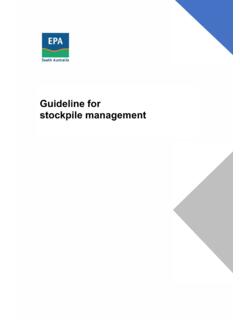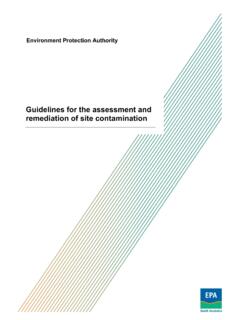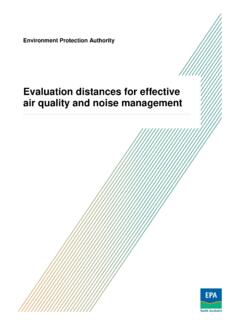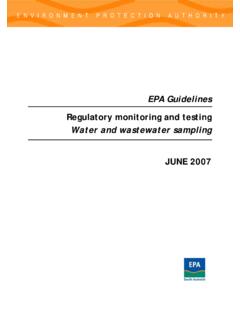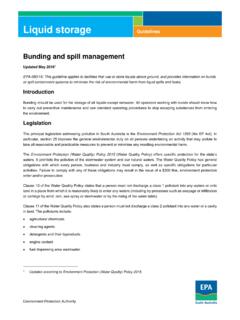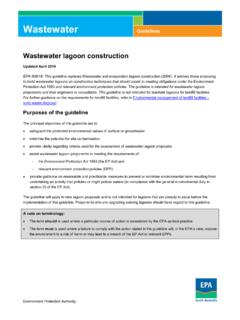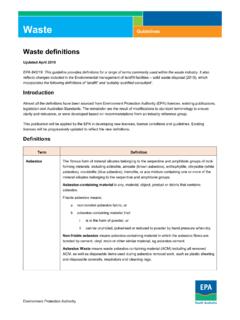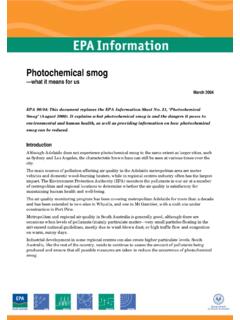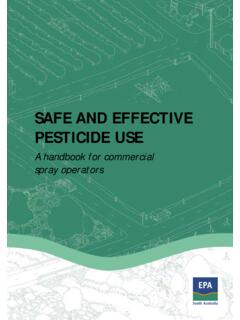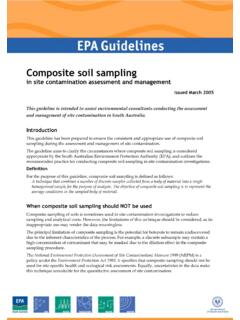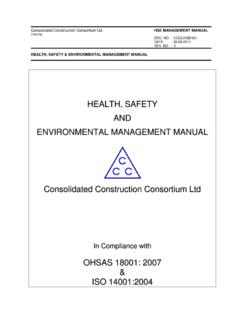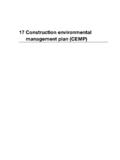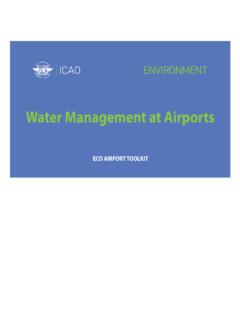Transcription of Construction environmental management plan (CEMP)
1 South Australia Industry Guidelines Construction environmental management plan (CEMP) Updated October 20211 EPA 1095/21: This guideline describes the impacts of Construction activities and the information that should be included in a Construction environmental management plan (CEMP) to ensure activities will be managed to avoid or mitigate environmental or nuisance impacts.
2 Introduction Construction activities include demolition work, site preparation, building maintenance or repair work, the operation of vehicles entering or leaving the Construction site, and activities (at or within the immediate vicinity of a Construction site), of persons who perform work at the site, or tasks connected with work at the site2. Activities at Construction sites can result in the discharge of polluted water that detrimentally affects local watercourses or the marine environment, emission of noise, dust, or odours that cause nuisance or potential health impacts, the escape of litter from the site, or excavation or importation of unsuitable fill materials.
3 All of these potential off-site impacts should be considered prior to Construction occurring and an effective plan should be developed to manage impacts on the natural environment, and to prevent foreseeable nuisance and health impacts on sensitive receivers3. Regulation of Construction activities Regulation of the environmental impacts of Construction may be undertaken through the Local Nuisance and Litter Control Act 2016 (LNLC Act) or the Environment Protection Act 1993 (EP Act), depending on the circumstances. The LNLC Act was enacted to regulate local nuisance and littering. Local nuisance is any adverse effect on the amenity of an area that is caused by noise, vibration, odour, smoke, fumes, aerosols, dust, or dead or alive animals that unreasonably interferes with the enjoyment of the area by persons occupying a place within or lawfully resorting to the 1 Issued July 2018 2 Construction activities are defined in the Environment Protection (Noise) Policy 2007.
4 3 A sensitive receiver is defined in Evaluation distances for effective air quality and noise management (2019) to be: any fixed location (including a house, building, other premises or open area) where: human health may be affected by air emissions from existing or proposed development, and/or property damage or loss of amenity may be caused by air emissions from the existing or proposed development,and/or noise -affected premises (whether existing or future, based on land use zoning) that are in separate occupation fromthe existing or proposed noise source and used for residential or business purposes or constitute a quiet ambientenvironment set aside for public recreation and enjoyment, and/or plants, animals or ecosystems that may be affected by air and/or noise Protection Authority Construction environmental management plan area.
5 For the purpose of the LNLC Act, litter includes not only hazardous and general litter, but also stormwater runoff, and vehicle drag-out containing building or Construction material. Causing a local nuisance or littering while undertaking Construction activities may contravene the LNLC Act. In accordance with the LNLC Act, a council is the principal authority for dealing with local nuisance and littering in its area. The Act does not apply in relation to an activity licensed under the EP Act. Instead, the EPA is responsible for addressing nuisance associated with licensed activities. If a council has reason to believe that an offence of environmental nuisance or littering has, or may have, caused material or serious environmental harm within the meaning of the EP Act, it must notify the EPA as soon as practicable, so that the EPA can address such matters.
6 The EP Act provides the regulatory framework to protect South Australia s environment including land, air and water. It is administered through a suite of legislative and non-legislative policies and regulatory tools that impose mandatory provisions with penalties to address environmental issues. Subordinate legislation includes environment protection policies (Environment Protection (Air Quality) Policy 2016 (AQ EPP), Environment Protection (Noise) Policy 2007 (Noise EPP), Environment Protection (Waste to Resources) Policy 2010 (Waste to Resources EPP) and the Environment Protection (Water Quality) Policy 2015. The EP Act and associated environment protection policies contain provisions that may apply to Construction activities.)
7 What is a CEMP? A CEMP describes how activities undertaken during the Construction phase of development will be managed to avoid or mitigate environmental or nuisance impacts, and how those environmental management requirements will be implemented. A CEMP should be prepared when there is a risk that Construction activities could cause environmental harm or environmental nuisance. Triggers for preparing a CEMP could also include any of the following (or any other relevant) circumstances applying to the site: It is located in the catchment of a water-sensitive region such as a water protection area declared under the EP Act (including River Murray, Mount Lofty Ranges and South East), Adelaide coastal waters, and Lower and Upper Spencer Gulf.
8 It is located near surface or underground waters. It is located near a sensitive receiver. Site contamination may exist. Waste soils, Construction and demolition waste may be imported or removed. When the EPA will seek a CEMP A development approval issued by a relevant authority (local council, State Commission Assessment Panel, Minister for Planning or Governor) can have conditions relating to the minimisation of environmental harm and local nuisance during the Construction phase. A common condition is the requirement to prepare a CEMP. When assessing a referred development application (DA) or impact assessed development, the EPA may (when it relates to the DA referral trigger) seek a CEMP as part of that assessment, or advise or direct that a condition requiring preparation of a CEMP to the satisfaction of the EPA and/or the relevant authority be attached to the approval.
9 In order to create a clear distinction between local council and EPA responsibilities in relation to local nuisance issues (given the interaction between the LNLC Act and EP Act), the EPA will only seek a CEMP during the DA assessment process or advise or direct a condition requiring a CEMP when any of the following situations apply: The proposal relates to an activity currently licensed under the EP Act and there is concern about Construction -phase impacts on the environment and sensitive receivers. 2 Construction environmental management plan The proposal is for a retail petrol station that includes the removal of existing underground fuel storage tanks.
10 The referral is for impact assessed development being assessed in accordance with the Planning Development and Infrastructure Act 2016 that poses a high risk of causing material or serious environmental harm during the Construction phase (due to the location, scale and/or nature of the proposal). The proposal involves any other activity that the EPA determines has a priority risk when assessed according to standard EPA environmental risk-based analysis procedures. Contents of the CEMP A CEMP needs to contain sufficient information to demonstrate that potential impacts on the environment, and public health and amenity have been identified, and suitable measures to mitigate those impacts will be applied prior to and during Construction .
